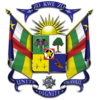Portal:The Central African Republic
The Central African Republic Portal
The Central African Republic (CAR; Sango: Ködörösêse tî Bêafrîka; French: République centrafricaine, RCA; French: [ʁepyblik sɑ̃tʁafʁikɛn], or Centrafrique, [sɑ̃tʁafʁik]) is a landlocked country in Central Africa. It is bordered by Chad to the north, Sudan to the northeast, South Sudan to the southeast, the DR Congo to the south, the Republic of the Congo to the southwest, and Cameroon to the west. The Central African Republic covers a land area of about 620,000 square kilometres (240,000 sq mi). , it had an estimated population of around 4.7 million. , the Central African Republic is the scene of a civil war, ongoing since 2012. Most of the Central African Republic consists of Sudano-Guinean savannas, but the country also includes a Sahelo-Sudanian zone in the north and an equatorial forest zone in the south. Two-thirds of the country is within the Ubangi River basin (which flows into the Congo), while the remaining third lies in the basin of the Chari, which flows into Lake Chad. What is today the Central African Republic has been inhabited for millennia; however, the country's current borders were established by France, which ruled the country as a colony starting in the late 19th century. After gaining independence from France in 1960, the Central African Republic was ruled by a series of autocratic leaders, including an abortive attempt at a monarchy. By the 1990s, calls for democracy led to the first multi-party democratic elections in 1993. Ange-Félix Patassé became president, but was later removed by General François Bozizé in the 2003 coup. The Central African Republic Bush War began in 2004 and, despite a peace treaty in 2007 and another in 2011, civil war resumed in 2012. The civil war perpetuated the country's poor human rights record: it was characterized by widespread and increasing abuses by various participating armed groups, such as arbitrary imprisonment, torture, and restrictions on freedom of the press and freedom of movement. (Full article...) Selected article -
An internal conflict in the Central African Republic (CAR) started essentially on 13 April 2013, when the government of President Michel Djotodia officially took over. The fighting was between the government of the Central African Republic's former Séléka coalition of rebel groups, who are mainly from the Muslim minority, and the mainly Christian anti-balaka coalition. The conflict was part of the ongoing Central African Republic Civil War (2012–present). International organisations, such as the United Nations, had warned of a possible genocide. UNSC resolution 2122 authorised the African-led International Support Mission to the Central African Republic (MISCA) to be deployed to the country, and France to lead operations with additional troops sent to bolster its force in the country. Following a summit of Economic Community of Central African States (CEEAC), including the attendance of all the country's MPs, Djotodia resigned from the presidency on 10 January 2014. The National Transitional Council chose Bangui mayor Catherine Samba-Panza as interim president on 20 January 2014. A period of lawlessness prevailed during the early days of her presidency with people moving into religiously cleansed neighbourhoods as the UN warned of a genocide. Anti-Balaka attacks continued against Muslim civilians. (Full article...)
General images -The following are images from various Central African Republic-related articles on Wikipedia.
MapDid you know (auto-generated)Entries here consist of Featured articles and Good articles, which consist of high-quality content on English Wikipedia..
Bangui (French pronunciation: [bɑ̃ɡi]) (or Bangî in Sango, formerly written Bangi in English) is the capital and largest city of the Central African Republic. it had an estimated population of 889,231. It was established as a French outpost in 1889 and named after its location on the northern bank of the Ubangi River (French: Oubangui); the Ubangi itself was named from the Bobangi word for the "rapids" located beside the settlement, which marked the end of navigable water north from Brazzaville. The majority of the population of the Central African Republic lives in the western parts of the country, in Bangui and the surrounding area. The city forms an autonomous commune (commune autonome) of the Central African Republic which is surrounded by the Ombella-M'Poko prefecture. With an area of 67 square kilometres (26 sq mi), the commune is the smallest high-level administrative division in the country, but the highest in terms of population. The city consists of eight urban districts (arrondissements), 16 groups (groupements) and 205 neighbourhoods (quartiers). As the capital of the Central African Republic, Bangui acts as an administrative, trade, and commercial centre. It is served by the Bangui M'Poko International Airport. The National Assembly, government buildings, banks, foreign enterprises and embassies, hospitals, hotels, main markets and the Ngaragba Central Prison are all located here. Bangui manufactures textiles, food products, beer, shoes and soap. Its Notre-Dame Cathedral is the seat of the Roman Catholic Archdiocese of Bangui. The city is also home to the University of Bangui, inaugurated in 1970. (Full article...)CategoriesSelect [►] to view subcategories
WikiProjectsRelated portalsCities
* not the capital of the prefecture
|
||||||||||||||||||||||||||||||||||||||||||||||||||||||||||||||||
This page was last updated at 2022-02-06 05:23 UTC. Update now. View original page.
All our content comes from Wikipedia and under the Creative Commons Attribution-ShareAlike License.






































